Abstract
To reduce the structural vibration of the duct structure in pump-jet propulsors (PJPs) and lower the induced vibration noise, this study learned from the “processor box” in an aero-engine and set a certain number of axial slots in the PJP. First, using finite element analysis, both dry and wet modes of the PJP ducts with and without an axial slot structure were simulated for analysis. Next, with the two-way fluid–solid coupling calculation method, the vibration performances of the PJP ducts with and without axial slots were contrasted and studied. The differences in calculation results under different duct structures were compared from three aspects—the vibration displacement, velocity, and acceleration of the duct and mesh nodes. According to the present results, after the addition of axial slots, the vibration displacement, the vibration velocity, and the vibration acceleration can be significantly reduced, especially in the back segment of the duct. Meanwhile, it can be concluded that it is quite important to select vibration acceleration for structural analysis in evaluating the PJP vibration. This study can provide a reference for further designs of low-noise PJPs.
1. Introduction
Due to high propulsive efficiency and favorable acoustic stealth performance, pump-jet propulsors (PJPs) have gradually been mounted on some military equipment, mainly submarines and high-speed torpedoes [1,2,3]. PJPs can generate flow noise and structural noise during their operation. Low noise is an important index in the design to enhance stealth capabilities. Gaining in-depth knowledge of the vibration performance of PJP ducts and achieving effective control of duct vibration are necessary to enhance submarines’ acoustic stealth capabilities.
Currently, only a few numerical simulations have been performed on the vibration of the PJP duct. Because of the limited computing resources [4], high-precision numerical prediction results are hard to obtain quickly. Meanwhile, measuring the dynamic load on the duct when the PJP operates underwater is difficult [5,6], as sufficient measurement data to validate the prediction results is lacking [7,8]. Scholars worldwide have researched the vibration and noise reduction of pump propulsors. Zhao [9] investigated the sound production mechanism of the coupled model of a torpedo and a PJP and determined the distribution of the main noise sources and the sound production reasons under flow interference. Lu [10] predicted the radiation noise of a PJP and focused on the effect of the duct on the rotor’s sound field; it was found that the duct imposed a side-wall shielding effect on the radial measuring points while almost no effect was observed on the axial measuring points. Liu [11] performed finite element analysis on the noise characteristics of the PJP by taking the aero-engine duct as the reference. Based on the analysis of frequency spectral curves and sound source directivity, it was found that the duct had a slight effect on noise in the low-frequency range but reduced the noise pressure level and changed the directivity in the high-frequency range. Gao [12,13] calculated the structural noise of the PJP and analyzed the relations of acoustic radiation power and the means square vibration speed parameters with the frequency of the exciting force on the blade and wet-mode frequency, which can provide a reference for the acoustic–vibration coupled calculation and the vibration attenuation structural design of pump-jets. Through 2D numerical calculation, Lin [14] pointed out that the duct affected the diffraction of the propulsor’s line spectra. NASA [15] proposed an interior acoustic design for an aero-engine based on the TBIEM3D model, including the sound absorption design of the acoustic lining of the duct, the shape design of the duct nozzle, and the aerodynamic vibration design of the duct, promoting applications in some specific items. Tyler and Sofrin [16] first proposed the concept of the acoustic mode for the duct and performed modal analysis to reveal the propagation and attenuation rules of different blades in the duct with different frequency modes; accordingly, they proposed that the duct noise can be inhibited with mode interaction.
In the field of passive flow control and vibration suppression, scholars at home and abroad have conducted a series of research works. Qin et al. [17] and Sun et al. [18] proposed a kind of PJP with a jagged duct; based on DES, they predicted the underground radiation noise of the PJP and concluded that the jagged duct could remarkably lower the radiation noise of the PJP. Yu [19,20] conducted a simulation on the PJP and pointed out that the maximum deformation of the blade appeared at the blade tip; meanwhile, they proposed the design of a novel PJP with smaller vibration displacement. Ducoin [21] used experimental and CFD methods to study the flow field of hydrofoils under different operating conditions, and found that increasing the pitching speed of hydrofoils can delay the transition from laminar to turbulent flow and increase the hysteresis effect during the pitching motion. The increase in hysteresis effect during pitching motion leads to a significant increase in hydrodynamic load. Mustafa et al. [22] used roughness elements on the suction front edge of a NACA airfoil, causing an increase in the boundary layer flow momentum, which inhibited the flow separation on the surface of the airfoil and resulted in a significant increase in the aerodynamic lift of the airfoil. Koca and Genc [23] conducted wind tunnel tests on turbine blades with different airfoil profiles and the results showed that airfoils with different thicknesses and camber angles form laminar flow separation bubbles, which lead to aerodynamic momentum variations over time, which may trigger random vibrations of the blades. Koca et al. [24] investigated the effect of LFM on aerodynamic phenomena on the surface of turbine blades by means of experimental studies and found that LFM ensures a positive effect, especially in the pre-stall and post-stall regions, with fewer fluctuations in the lift curve, which means that aerodynamic vibrations and noise of turbomachinery can be reduced. Koca and Genc [25] investigated the effect of laminar flow separation bubbles on the structural vibration and aerodynamic noise on the blade surface, and showed that the blades indicate a locally flexible structure, which ensures a reduction in the external loads due to vortex-excited vibration on the blade surface.
This study focuses on a PJP to investigate the effect of an axial slot structure on the vibration control performance of the PJP duct, and innovatively sets a certain number of axial slots on the inner wall of the duct. Next, numerical calculation is performed on the vibration characteristics of the ducts with and without axial slots. The effect of the axial slots on the vibration performance of the duct in the PJP is analyzed through comparison. This paper provides a reference for the design of low-noise PJPs.
2. Fluid-Solid Coupling Analysis
2.1. Control Equation of Fluid
The basic principles of fluid flow can be established by the mass, momentum, energy, and turbulence characteristics of the conservation of the system of equations, such as the continuity equation, momentum equation, etc. These equations constitute a system of coupled nonlinear partial differential equations, which cannot be solved by the classical analytical method, but only by numerical methods to solve the flow characteristics of the fluid.
In this study, it can be assumed that the flowing behaviors in the PJP obey the following characteristics—3D, viscosity, and incompressibility. Under those assumptions, the following continuity and momentum equations can describe the flow behaviors of the PJP.
The equation of continuity can be written as follows:
The momentum equation can be written as follows:
where denotes the pressure; denotes the fluid density; denotes the dynamic viscosity of fluid; () denote the rectangular coordinates in the x-axis, y-axis, and z-axis, respectively; () denote the components of fluid velocity along the x-axis, y-axis, and z-axis directions; denotes time; and is the generalized source item in the momentum equation.
2.2. Turbulence Model
In this study, the detached-eddy simulation model was adopted as the turbulence model. Concerning the DES model, the high-precision LES method was used for the near-wall region. The RANS method was used in the turbulent core region, which can significantly reduce the calculated amount and ensure the calculation efficiency without sacrificing calculation precision [26]. Since the DES model’s detailed derivation process can be seen in [27,28,29,30], it is not repeated in this study.
2.3. Control Equation of Solid
The solid governing equation is a mathematical expression for studying the force behavior of an object, which describes the deformation and stress distribution law of an object under force. When performing fluid–solid coupling analysis on the PJP, the vibration of the structure under the combined action of internal and external forces should be given special consideration to adequately determine the effect of the time-dependent motion of the structure on the motion of the fluid. The motion equation of the structure can be written as follows:
where , , and are the nodal displacement, velocity, and acceleration vectors, respectively. , , represent the system’s mass matrix, damping matrix, and stiffness matrix, respectively. represent the node load vectors.
2.4. Validation of Two-Way Fluid–Solid Coupling Numerical Calculation Method
Next, to validate the accuracy of the proposed two-way fluid–solid coupling numerical calculation method, this study selected the hydrofoil that Ducoin [31,32,33,34] performed tests with in 2009 as the research object. The calculation process was conducted on an ANSYS Workbench platform by coupling the CSD software (version 19.3) ANSYS Mechanical and the CFD software CFX version 2023. As shown in Figure 1, the chord length C and the elongation L of the hydrofoil were 0.15 m and 0.192 m, respectively. The cross-section of the flow channel cavity was 0.192 m × 0.192 m in size. The inflow velocity was 5 m/s, and the turbulence strength at the initial angle of attack was 2.94%. The elastic hydrofoil was prepared by POM, with an elastic modulus of E = 3 GPa, a density of = 1.48 × 103 kg/m3, and a Poisson’s ratio of = 0.35.
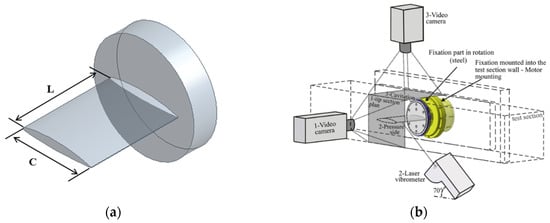
Figure 1.
Hydrofoil model and hydrofoil test [34]: (a) hydrofoil and rotating disc model; (b) elastic hydrofoil test equipment.
According to reference [35], the size of the computational domain is determined to ensure that the flow within the computational domain is fully developed. The distance between the fluid computational domain’s inlet and the hydrofoil’s leading edge was 1 C, and the distance between the outlet of the computational domain and the trailing edge was 2 C, where C represents the chord length of the hydrofoil. The distance between the top/bottom surface and the hydrofoil string was 0.96 m. The inlet and the outlet were set as the velocity inlet and the pressure outlet, respectively. In the solid domain, the root of the rotating disk was fixed for constraint. The pressure surface, the suction surface, the tail end surface, and the tip end surface were all set as fluid–solid coupling surfaces for data transmission with the flow field. Next, by performing coupling calculations on the deformations of the hydrofoil tip at different attachment angles, the maximum deformation at the tip of the elastic hydrofoil was extracted and compared with the experimental values given by Ducoin [34], as shown in Figure 2.
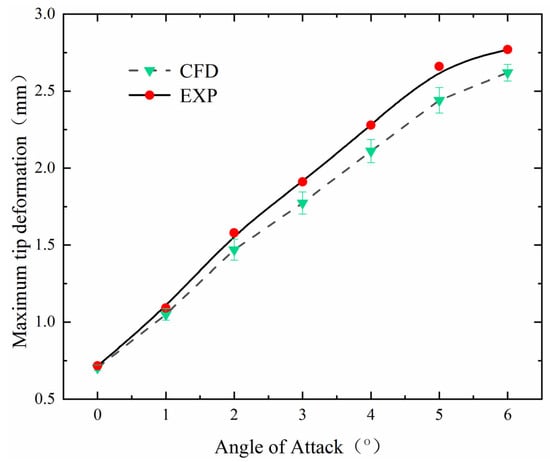
Figure 2.
Comparison of calculated and tested values of maximum deformation of hydrofoil tip.
According to Figure 2, the fluid–solid coupling calculated results fit well with the experimental values given by Ducoin [34], with high coincidence and identical tendency. This suggests that the established fluid–solid coupling calculation method can predict the deformation of the wing-shaped profile structure well, with favorable applicability.
3. Study on the Vibration Performance of the PJP Ducts with Different Structures
3.1. Geometrical Model
This study focused on a front-stator PJP. Specifically, the stator and the rotor had 13 blades and 7 blades, respectively. The NACA airfoil section and the accelerating duct were used. The minimum clearance between the inner wall of the duct and the end surface at the tip of the rotor was 2 mm. Figure 3 displays the PJP without and with axial slot structure ((a) and (b)), respectively.
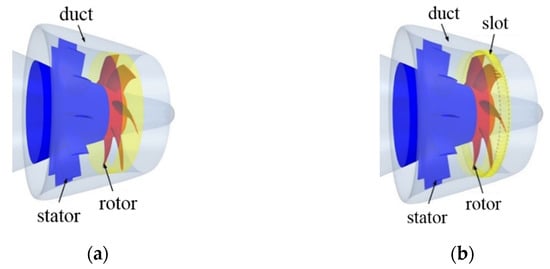
Figure 3.
Geometry of PJP: (a) without axial slots; (b) with axial slots.
The axial slot’s depth at the rotor tip’s leading edge was defined as the radial depth of the axial slot H. The axial slot was located right above the tip of the rotor. The axial positions of the end surface in front and back of the axial slot were flush with the front edge, and the trailing edge of the blade tip of the rotor, i.e., the axial length equaled the axial length of the end surface at the tip of the rotor. As shown in Figure 4, the number of axial slot grooves was 100, and the intersection angle between the axial slot’s axis and the rotor’s axis was 0°.
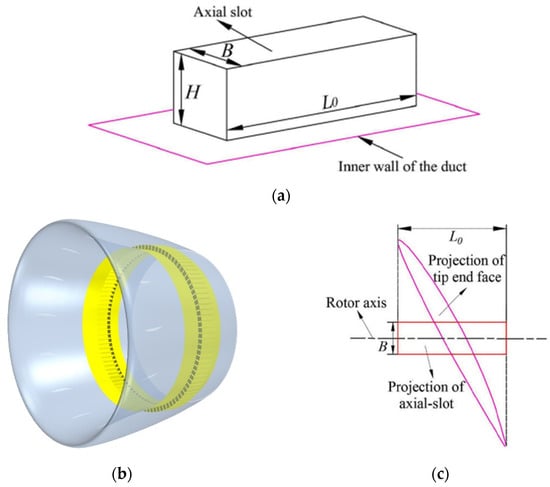
Figure 4.
The arrangement of axial slots: (a) the geometrical dimensions of axial slots; (b) number of axial slots; (c) relative position of axial slot.
3.2. Mesh Generation
The fluid computational domain was divided into structural hexahedral meshes; 1.82 × 107 and 2.0 × 107 meshes were generated in the computational domains for the structures with and without axial slot structure. The entire fluid computational domain consisted of the stator domain, rotor domain, tip domain, rotor posterior domain, and outer domain. The number of meshes in the stator domain, rotor domain, rotor posterior domain, and outer domain was 3.07 million, 4.8 million, 3.7 million, and 4.95 million, respectively. The number of meshes in the tip domain with and without axial slot structure was 3.48 million and 1.68 million, respectively. Figure 5 and Figure 6 display the meshed exterior domain and the posterior domain of the rotor. To ensure periodicity, meshes within the stator, rotor, and blade tip domains can be obtained by periodically rotating the single-channel meshes. Figure 7, Figure 8, Figure 9 and Figure 10 display the meshes in the stator, rotor, and blade tip domains, respectively.
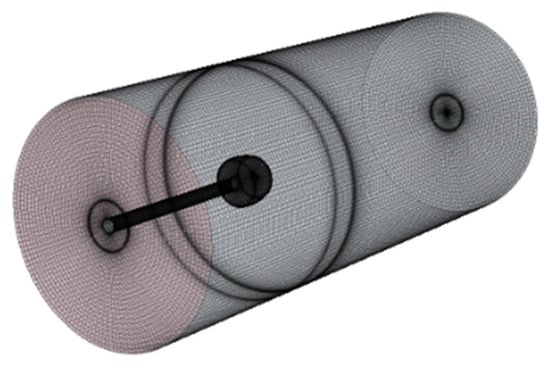
Figure 5.
External domain mesh.
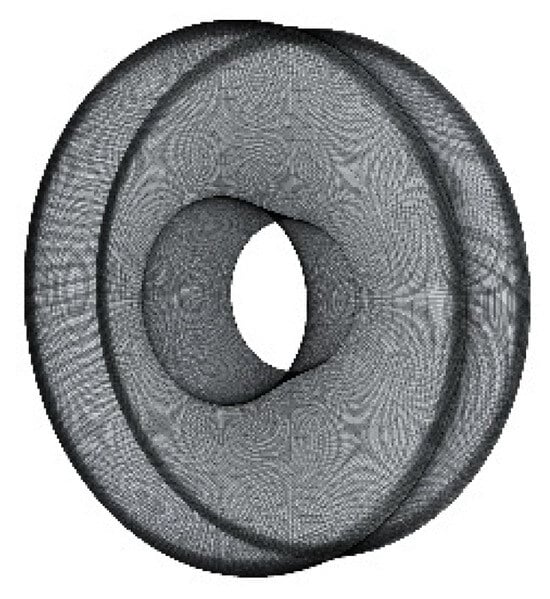
Figure 6.
Rotor posterior domain mesh.
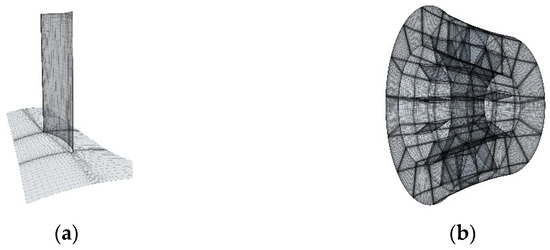
Figure 7.
Stator domain mesh: (a) single channel; (b) full channel.

Figure 8.
Rotor domain mesh: (a) single channel; (b) full channel.
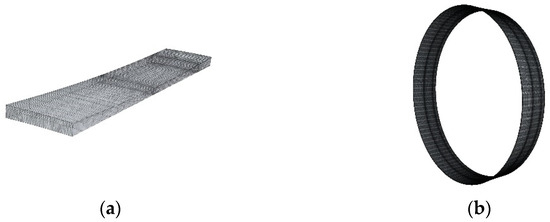
Figure 9.
Tip domain mesh without axial slots: (a) single channel; (b) full channel.
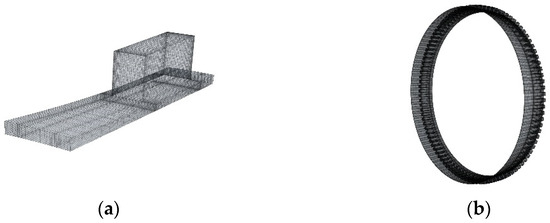
Figure 10.
Tip domain mesh with axial slots: (a) single channel; (b) Full channel.
Since the flow field around the rotor tip and in the gap of the blade tip shows quite complex patterns, denser meshes should be generated to accurately calculate the eddy flow at the rotor tip, as shown in Figure 11. Meanwhile, to better capture the pressure at the vortex core and the leakage vortex pattern at the tip, Hsiao [36] found that the computational accuracy can be high when the number of mesh nodes exceeded 15. Therefore, the trailing edge of the rotor should be more densely meshed in axial, radial, and circumferential directions.

Figure 11.
Mesh of the region near the top leakage vortex.
The solid-domain model of the duct was divided into tetrahedral meshes, and the number of meshes of the duct with and without axial slot structure are 80546 and 102790, respectively, as shown in Figure 12.

Figure 12.
PJP solid domain mesh: (a) duct mesh without axial slots; (b) duct mesh with axial slots.
4. Analysis of Calculation Results
4.1. Modal Analysis
Modal analysis should first be performed on the duct before dynamic analysis. The acquired natural frequency and modal shape can contribute to the duct’s vibration investigation and noise reduction design [37]. Meanwhile, the PJP duct can be optimized according to modal frequencies at different orders and the vibration characteristics of the duct under excitation.
The process of modal analysis consists of determining the mechanical property parameters of the duct material, then discretizing the computational domain, followed by imposing constraints, and then solving. This study performed simulations on dry and wet duct modes with and without axial slots, as shown in the first eight orders of inherent frequencies in Figure 13.
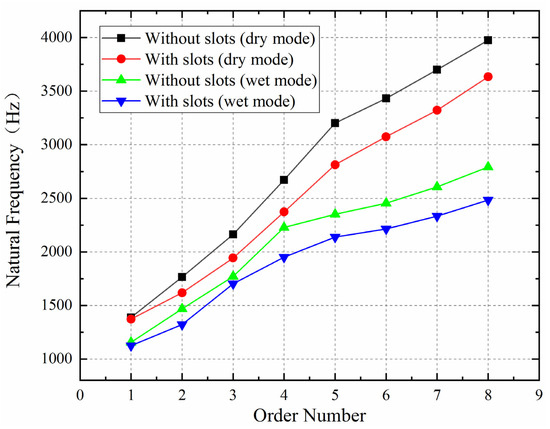
Figure 13.
The first 8 orders of natural frequencies of the dry and wet mode of the duct.
According to Figure 13, the inherent frequencies at dry and wet modes of the duct with axial slots were higher than the values of the duct without axial slots. This could be due to the decreased duct mass after setting axial slots on the inner wall surface, leading to a decline in the stiffness and the natural frequency. However, at low-order modes, the setting of the axial slot significantly affected the duct’s natural frequency. Due to the effect of the mass of added water, the inherent frequencies of the ducts with and without axial slots for wet modes were lower than the values for dry modes. Moreover, the effect of the mass of added water increased with the increasing modal order.
Resonance refers to the phenomenon in which the amplitude of a mechanical system increases significantly when the excited frequency of the mechanical system is close to the natural frequency of the system, and excessive deformation can cause structural damage. Resonance should be avoided in the design of axial slot structures, and the different orders of the natural frequency under modal analysis provide guidance for the design of axial slot structures.
The frequency of the external force on the duct is connected with the blade frequency of the rotor. In this study, seven blades rotated in the rotor at a speed of 1100 rpm. Accordingly, the blade frequency was 128.3 Hz, far smaller than the natural frequency in the first-order mode. Therefore. The designed PJP duct can operate safely under these operating conditions without the occurrence of resonance.
By comparing the vibration modes of the first eight orders of two different structures of ducts at dry and wet modes, it can be found that the duct with and without axial slots show almost identical vibration modes at dry and wet modes but differ in inherent frequencies. Accordingly, only the vibration modes of two different structures of ducts in the wet mode were displayed for further analysis, as shown in Figure 14 and Figure 15.

Figure 14.
Vibration modes of duct without axial slots in wet mode: (a) first-order vibration mode; (b) second-order vibration mode; (c) seventh-order vibration mode; (d) eighth-order vibration mode.

Figure 15.
Vibration modes of duct with axial slots in wet mode: (a) first-order vibration mode; (b) second-order vibration mode; (c) seventh-order vibration mode; (d) eighth-order vibration mode.
It can be observed from Figure 14 and Figure 15 that the first two orders of vibration modes of two different structures of PJP ducts were identical, and the maximum deformation of the duct appeared at the latter half of the duct. At the 7th and the 8th vibration modes, the first half part of the duct underwent great displacement and deformation. For the PJP duct with and without the axial slot, the vibration modes were almost identical except and only showed a slight difference at high-order frequencies, indicating a slight effect of the addition of the axial slot on the overall modal shape of the PJP duct.
4.2. Effects of Duct Structure on Overall Displacement, Velocity, and Acceleration
After the two-way fluid–solid coupling calculation reached the stable state, the calculation was prolonged for one more period, and the vibration displacement, velocity, and acceleration cloud charts of the PJP duct in a period were selected for analysis. Figure 16, Figure 17 and Figure 18 display the vibration displacement, velocity, and acceleration cloud charts of the PJP ducts with and without axial slot structure simultaneously.
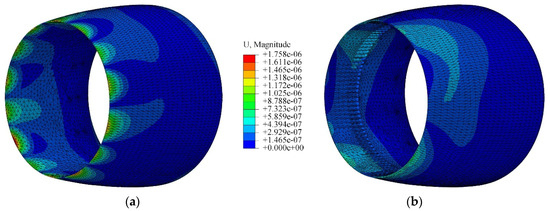
Figure 16.
Duct vibration displacement cloud chart: (a) without axial slots; (b) with axial slots.

Figure 17.
Duct vibration velocity cloud chart: (a) without axial slots; (b) with axial slots.

Figure 18.
Duct vibration acceleration cloud chart: (a) without axial slots; (b) with axial slots.
- (1)
- Overall, the vibration displacement, the vibration velocity, and the vibration acceleration of the PJP duct without an axial slot structure were greater than those of the duct with the axial slot. The displacement, the velocity, and the acceleration all occurred in the latter part of the duct. The first half part of the duct was fixed by the stator and slightly subjected to the excitation of the rotor, accompanied by negligible vibration displacement, velocity, and acceleration compared to the values in the second half part.
- (2)
- By analyzing the vibration displacement, velocity, and acceleration cloud charts of the PJP duct without an axial slot, 14 semi-circular maximum-value regions with uniform distribution along circumferential direction can be observed in the last part of the duct. The number of semi-circular maximum-value regions was twice the number of rotors. This is because an equal number of deformations with the number of rotors can be generated at the trailing edge of the duct towards the outside of the duct. Meanwhile, the adjacent regions underwent deformations toward the inside of the duct, showing the displacement in the opposite direction. It should be noted that only the values were displayed in the cloud charts without directions. Fourteen maximum-value regions were shown in the cloud charts.
- (3)
- The vibration displacement, velocity, and acceleration cloud charts of the PJP duct with axial slots were then analyzed. Under the suction on the flow field between blade tips by the axial slot structure, the fluid partly flowed into axial slots, and the flow field in the second part was no longer uniform and regular. Accordingly, for the PJP duct with axial slots, the vibration displacement, the velocity, and the acceleration all show nonuniform distributions on the cloud charts.
- (4)
- It can also be observed from the vibration acceleration cloud charts of the ducts with two different structures that the maximum acceleration appeared in the second part of the duct and the inner wall surface adjacent to the blade tip of the rotor. Figure 19 shows the vibration acceleration cloud charts of the duct without an axial slot structure and the duct and rotor positions, respectively.
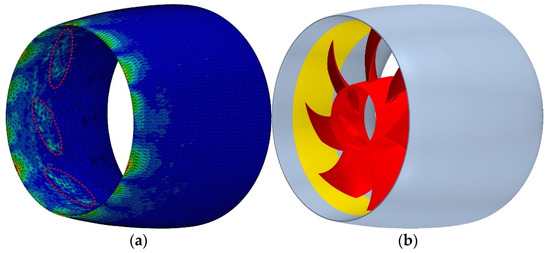 Figure 19. Duct vibration acceleration cloud chart and position diagram of rotor and duct without axial slots: (a) vibration acceleration cloud chart; (b) diagram of rotor and duct position.
Figure 19. Duct vibration acceleration cloud chart and position diagram of rotor and duct without axial slots: (a) vibration acceleration cloud chart; (b) diagram of rotor and duct position.
As shown in Figure 19, the maximum acceleration on the inner wall of the duct appeared at the projection position of the end surface at the blade tip on the inner wall surface of the duct, as marked by a red elliptic dotted line. Seven maximum acceleration points can be observed, suggesting a significant effect of the flow field force generated in high-speed rotation on the vibration acceleration of the duct structure.
Figure 18 shows the vibration acceleration cloud chart of the duct with an axial slot structure, from which maximum acceleration similar to the shape of the end surface at the blade tip can be observed at the axial slots. However, due to the control of the axial slot structure on the flow field in blade tip clearance, the magnitude and range of the vibration deceleration dropped.
4.3. Effects of Duct Structure on Vibration Displacement, Velocity, and Acceleration of the Mesh Node in the Duct
4.3.1. Analysis of the Results at the Mesh Nodes along the Circumferential Direction of the Duct
As described in Section 4.2, the vibration displacement, velocity, and acceleration of the second part of the duct were overall greater than the values of the first part. To investigate the overall deformation of the duct, the time averages of vibration deformation, velocity, and acceleration of 13 mesh nodes around the front edge and the trailing edge of the PJP ducts with two different structures were calculated for comparison. Figure 20 displays the positions of the selected nodes on the ducts. The same numbers are used to mark the nodes on the same characteristic line.
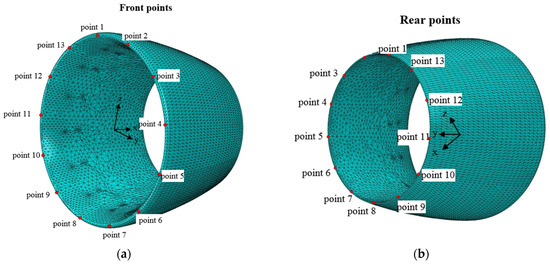
Figure 20.
Diagram of front and rear nodes of duct without axis slots: (a) 13 points on the front edge of the duct; (b) 13 points on the rear edge of the duct.
Figure 21, Figure 22 and Figure 23 show the time averages of vibration displacement, velocity, and acceleration of 13 mesh nodes on the PJP ducts with and without axial slots, respectively.
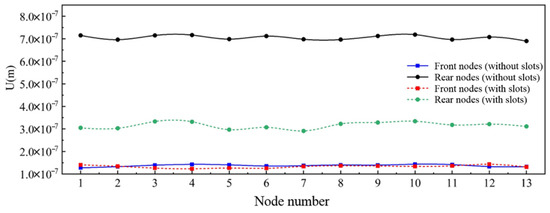
Figure 21.
Time-averaged values of vibration displacements at 13 nodes at the front and rear edges of the duct.
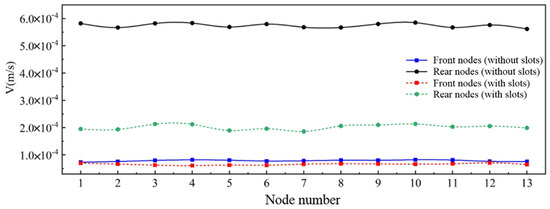
Figure 22.
Time-averaged values of vibration velocities at 13 nodes at the front and rear edges of the duct.
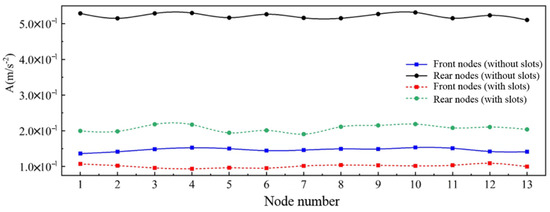
Figure 23.
Time-averaged values of vibration acceleration at 13 nodes at the front and rear edges of the duct.
In Figure 21, Figure 22 and Figure 23, the structures with and without axial slots are marked by a solid line and dashed line, respectively; the duct’s mesh nodes at the front edge and the trailing edge are marked by squares and dots, respectively. Through analysis, the following conclusions can be drawn:
- Overall, the vibration displacements, the velocities, and the accelerations of 13 mesh nodes at the trailing edge of the duct without an axial slot were larger than the values of the duct with an axial slot. The values of 13 mesh nodes at the front edge of the duct without an axial slot were slightly larger than those of the duct with an axial slot, with almost no difference.
- Generally, the mesh nodes at different positions simultaneously show different vibration displacements, velocities, and accelerations. However, on account of the central symmetry of the duct and the rotational periodicity of the rotor, the time averages of vibration displacement, velocity, and acceleration of various mesh nodes on the duct were almost identical. A slight difference can be attributed to the data selection within a period.
In the subsequent studies, the mesh nodes along characteristic lines in the circumferential direction of the duct were no longer selected to reduce the calculated amount. Only the mesh nodes on the characteristic lines at the same positions of two ducts with and without axial slots were selected for in-depth analysis.
4.3.2. Analysis of the Results at the Mesh Nodes along the Axial Direction of the Duct
The mesh nodes on the axial characteristic lines at the same positions of two different structures of PJP ducts were selected for analysis. As described in Section 3.2, 26 meshes were generated along the axial characteristic line. The duct can be divided into inner and outer parts and combined using structural analysis. Twenty-seven mesh nodes can be generated along the characteristic lines in the inner and outer parts, respectively. Figure 24 displays the positions of the selected mesh nodes in the duct without an axial slot. After setting the axial slot, the mesh nodes at the edge of the nearest axial wall surface were selected, as shown in Figure 25. The serial numbers of the selected nodes on the ducts with two different structures were identical and marked as inner and outer.
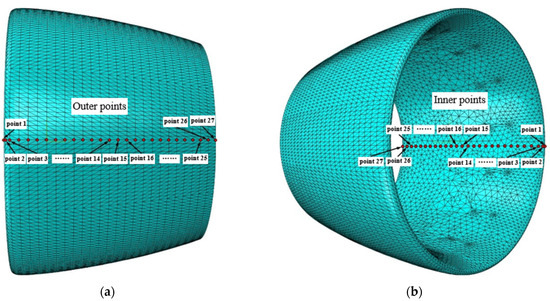
Figure 24.
Diagram of inner and outer nodes of duct without axial slots: (a) 27 points on the outer of the duct; (b) 27 points on the inner of the duct.

Figure 25.
Diagram of inner nodes of duct with axial slots.
Figure 26, Figure 27 and Figure 28 show the time averages of vibration displacement, velocity, and acceleration of 27 mesh nodes on the PJP ducts with and without axial slots, respectively. Ld in the horizontal coordinate represents the length of the duct.
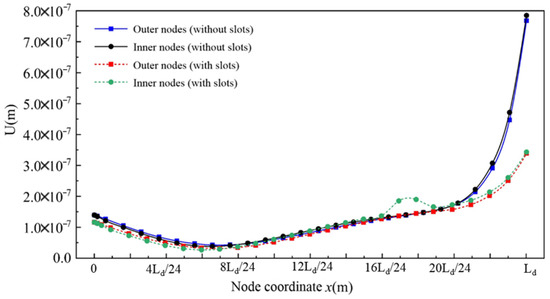
Figure 26.
Time-averaged values of vibration displacements of 27 nodes inside and outside the duct for the two structures.
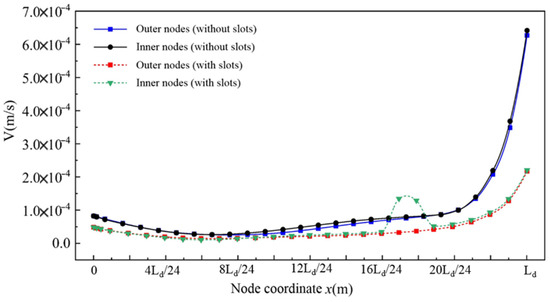
Figure 27.
Time-averaged values of vibration velocities of 27 nodes inside and outside the duct for the two structures.
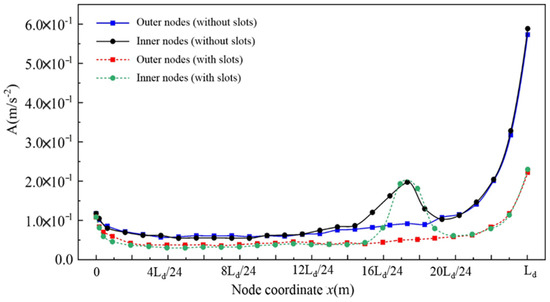
Figure 28.
Time-averaged values of vibration acceleration of 27 nodes inside and outside the duct for the two structures.
In Figure 26, Figure 27 and Figure 28, the structures with and without axial slots are marked by a solid line and dashed line, respectively; the duct’s mesh nodes at the front and the trailing edges are marked by squares and dots, respectively. In addition, the x-axis coordinates of the 27 nodes from front to back are also marked. The x-axis coordinates of the first node at the front edge of the duct and the last node at the trailing edge of the duct are 0 and Ld, respectively. Through analysis, the following conclusions can be drawn:
- Overall, the time averages of vibration displacement, velocity, and acceleration of the duct without axial slots were greater than those of the duct with axial slots. The acceleration difference between the two ducts was most obvious, followed by the difference in velocity, and the displacements of the two structures differed most slightly.
- For the ducts with two structures, the time averages of the latter part’s vibration displacement, velocity, and acceleration were greater than the values of the first part. In the first part, the time averages of vibration displacement, velocity, and acceleration dropped gradually from the front edge to the stator (at around x = 6Ld/24).
- The vibration displacements, the velocities, and the accelerations at the inner and the outer nodes differed slightly for the ducts with two structures (except the nodes in the range x = 16Ld/24 − 19Ld/24).
- The nodes with an x-axis coordinate (16Ld/24 − 19Ld/24) were along the axial slot. These nodes were subjected to flow force generated in high-speed rotor rotation, showing greater vibration displacements, velocities, and accelerations.
- In the range from the front edge of the duct to the stator, the vibration displacements, the velocities, and the accelerations of the outer nodes were slightly greater than the values of the inner nodes. This is because this segment was close to the stator, and the inside of the duct was fixed by the stator and hardly deformed. However, in the range from the stator to the trailing edge of the duct, the vibration displacements, the velocities, and the accelerations of the inner nodes were slightly greater than the values of the outer nodes. Since the back end of the ducts was not fixed, and the inside was subjected to flow field force generated by high-speed rotation of the rotor, greater deformation was produced in the latter part.
- It can be observed from time-averaging curves that the vibration displacements and the velocities of the nodes along the axial slot were larger than the values of the duct without axial slots. For the duct without axial slots, no suction of axial slots existed. The tip leakage vortexes generated under the pressure difference between the blade surface and the blade back of the rotor stuck to the end surface at the blade tip without diversion towards the inner wall surface of the duct. The inner wall surface of the duct without axial slots still acted as the main flow field in the duct from the inlet to the outlet. However, due to the suction of the axial slots, the flow field in the blade tip clearance diverted towards the axial slot, forming a vortex structure. Due to the diverted flow field’s action, the axial wall surface deformation on the axial slot increased. Meanwhile, since the wall surface of the axial slot was thin, it was quite easily deformed under the flow field force generated by the rotation of the rotor.
- It can be observed from time-averaging curves of the vibration accelerations that the values of the ducts with two structures increased obviously at the position of the axial slot; however, both the range and the amplitude of the maximum acceleration of the duct with the axial slots were lower than those of the duct without axial slots. This is consistent with the above analysis of the cloud chart. It also suggests that acceleration is important for structural analysis and vibration assessment of the PJP duct.
4.3.3. Analysis of the Results at the Mesh Nodes along the Axial Slots
Based on the above analysis, the time averages of vibration displacement, velocity, and acceleration of the nodes on the axial wall surface of the slot were higher than the values of the nodes in the first part of the duct. No comparison was performed among the nodes in the axial slot structure. Next, the time averages of vibration displacement, velocity, and acceleration of the nodes on the wall surface of the axial slot and in the axial slot were compared with the nodes’ values at the same duct positions without the axial slot. Figure 29 displays the positions of the nodes selected for analysis.
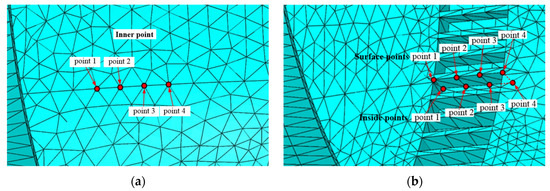
Figure 29.
Diagram of nodes at axial slots position of duct of two structures: (a) without axial slots; (b) with axial slots.
It can be observed from Figure 29 that three units were located on the duct with axial slots, four nodes were located on the axial wall surface of the axial slot, four nodes were located on the adjacent wall surface in the axial slot, and four nodes at the same or the adjacent positions on the axial slot were located on the duct without the axial slot.
Figure 30, Figure 31 and Figure 32 display the time averages of vibration displacement, velocity, and acceleration of four nodes on the PJP duct with two structures. These four nodes were located around the axial slot position.
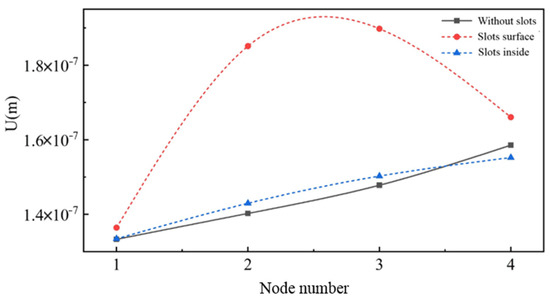
Figure 30.
Time-averaged values of vibration displacements at the 4 nodes in the axial slot position of the duct.
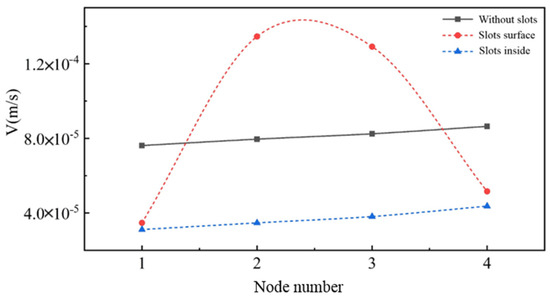
Figure 31.
Time-averaged values of vibration velocities at the 4 nodes in the axial slot position of the duct.
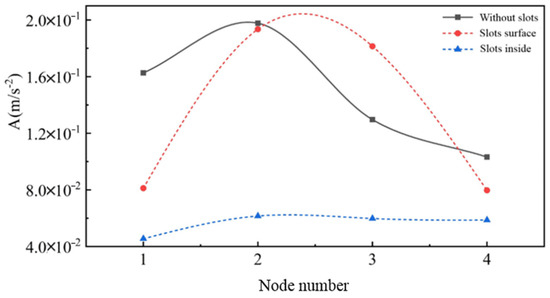
Figure 32.
Time-averaged values of vibration acceleration at the 4 nodes in the axial slot position of the duct.
According to the analysis, it can be easily observed that the time averages of vibration displacement, velocity, and acceleration of the nodes in the axial slot were smaller than the values of the other two nodes, suggesting that the flow field around the inner wall surface of axial slot structure was not violent. The effect of suction on the axial slot was mainly concentrated on the axial wall surface while imposing a slight effect on the top wall surface.
5. Conclusions
In this study, the dry/wet modal shapes of the PJP duct with and without an axial slot structure were analyzed and compared using finite element analysis. Next, the axial slot structure’s effect on the duct’s vibration was investigated based on two-way fluid–solid coupling calculation. The following conclusions can be drawn by comparing the time averages of vibration displacement, velocity, and acceleration and the ducts with and without the axial slot structure:
- (1)
- Compared with the duct without an axial slot, the duct with an axial slot showed decreased mass and stiffness and slightly declined natural frequency.
- (2)
- For these two types of PJP ducts, the modal shapes were roughly the same and only differed slightly in the high-frequency range, suggesting a slight effect of the addition of axial slot structure on the overall modal shape.
- (3)
- After adding an axial slot structure, the vibration displacement, velocity, and acceleration were reduced. The differences in vibration displacement, velocity, and acceleration between the two ducts mainly lay in the latter part. Since the first part of the duct showed great mass and thickness and was fixed by a stator, the vibration displacement, velocity, and acceleration were overall quite low, with slight differences. For the duct without axial slots, 14 semi-circular maximum-value regions can be observed at the trailing edge. The number of the maximum-value regions was twice the number of the rotor blades.
- (4)
- On account of the high-speed rotation of the rotor on the flow field, an obvious maximum of the vibration acceleration can be observed on the inner wall of the duct near the tip of the rotor blade, which was identical to the projected result of the rotor blade tip on the inner wall surface in terms of shape and direction. This suggests that structural analysis with acceleration is important for the vibration assessment of the PJP system.
- (5)
- The wall surface of the axial slot was quite thin. The vibration displacement, velocity, and acceleration at the edge of the wall surface were greater than the values on the inner wall surface at the same duct position without an axial slot. After adding axial slots, the vibration displacement, the velocity, and the acceleration of the nodes on the top wall surface were slightly affected.
This paper innovatively opens a certain number of axial slots inside the PJP duct, and finds that the duct with axial slot shows reduced vibration displacement relative to the conventional PJP duct. Subsequently, the effect of axial slot geometry parameters on the vibration of PJPs can be studied, which provides a new way for the design of low-noise PJPs.
Author Contributions
Methodology—L.K.; Data curation—J.Y.; Investigation—X.Z.; All authors have read and agreed to the published version of the manuscript.
Funding
This research was funded by the National Natural Science Foundation of China (Grant No. 51579243).
Data Availability Statement
Data are contained within the article.
Acknowledgments
Authors express their gratitute to the National Natural Science Foundation of China.
Conflicts of Interest
The authors declare no conflict of interest.
Abbreviations
List of Terms and Symbols
| PJP | Pump-jet propulsor |
| NASA | National Aeronautics and Space Administration |
| LFM | Local flexible membrane |
| DES | Detached-Eddy Simulation |
| LES | Large eddy simulation |
| RANS | Reynolds Average Navier-Stokes |
| POM | Polyacetate material |
| C | The chord length of the hydrofoil |
| L | The elongation L of the hydrofoil |
| B | Width of the axial slots |
| H | Depth of the axial slots |
| L0 | Length of the axial slots |
| Ld | Length of the duct |
References
- Li, F.; Huang, Q.; Pan, G.; Wu, B.; Li, H. Transient analysis of the pre-whirl pump-jet propulsor with different blade numbers. Ships Offshore Struct. 2022, 18, 846–858. [Google Scholar] [CrossRef]
- Li, X.R.; Ding, Y.; Wang, W.G. The hydrodynamic performance analysis of a submarine with new pump-jet propulsor. J. Ocean Eng. 2022, 245, 110542. [Google Scholar] [CrossRef]
- Qin, D.; Huang, Q.; Pan, G.; Shi, Y.; Han, P.; Dong, X. Effect of the duct and the pre-swirl stator on the wake dynamics of a pre-swirl pumpjet propulsor. Ocean Eng. 2021, 237, 109620. [Google Scholar] [CrossRef]
- Yao, H.Y.; Cao, L.L.; Zhang, Y.; Wu, D.Z.; Yu, F.X. Study on the effect of sublattice model on the prediction of broadband non-constant force of pump-jet thruster. Propuls. Technol. 2022, 43. [Google Scholar]
- Liu, Y.B. Research on the Design Method of Pump-Jet Propulsion for Underwater Vehicles. Ph.D. Thesis, Harbin Engineering University, Harbin, China, 2013. [Google Scholar]
- Gu, L. Research on Torpedo Pump Jet Thruster Design and Hydrodynamic Performance Prediction Method. Ph.D. Thesis, Harbin Engineering University, Harbin, China, 2019. [Google Scholar]
- Huang, Z.; Xiong, Y.; Lu, L. A review of research on fluid-solid coupled vibration noise of composite propellers. J. Harbin Eng. Univ. 2020, 41, 87–94+124. [Google Scholar]
- Xu, Y.; Xiong, Y.; Huang, Z. A review of the current status of research on hollow bubble-free propeller-induced noise of ships. J. Wuhan Univ. Technol. 2019, 43, 860–871. [Google Scholar]
- Zhao, B.; Yin, S.P.; Gao, C.; Cai, W.J.; Gao, Z.Y. Torpedo pump jet thruster flow interference acoustic mechanism. Torpedo Technol. 2009, 17, 4. [Google Scholar]
- Lu, D.D.; Fu, J. Effect of pump jet thruster duct on rotor acoustic field. Torpedo Technol. 2016, 24, 5. [Google Scholar]
- Liu, M.; Zhang, N.; Li, X.W.; Zhou, Y.M. Effect of pump jet propulsion duct on noise propagation characteristics. Ship Sci. Technol. 2011, 33, 4. [Google Scholar]
- Gao, D.N.; Yu, H.T.; Hua, H.X. Numerical analysis of acousto-vibration coupled response of pump-jet thruster under fluid excitation. Noise Vib. Control 2018, 38, 6. [Google Scholar]
- Gao, D.N. Research on New High-Efficiency and Low-Noise Pump Injection Technology. Ph.D. Thesis, Shanghai Jiaotong University, Shanghai, China, 2018. [Google Scholar]
- Lin, D.K.; Li, X.D. High-Order Numerical Simulation of Pipeline Sound Radiation. In Proceedings of the 10th Ship Underwater Noise Symposium, 2005; Available online: https://xueshu.baidu.com/usercenter/paper/show?paperid=4c3080fa19352cd79a4e92963ec4684c&site=xueshu_se (accessed on 7 November 2023).
- Dunn, M.; Tweed, J.; Farassat, F. The application of a boundary integral equation method to the prediction of ducted fan engine noise. J. Sound Vib. 1999, 227, 1019–1048. [Google Scholar] [CrossRef]
- Tyler, J.M.; Sofrin, T.G. Axial Flow Compressor Noise Studies; SAE Technical Paper; SAE International: Warrendale, PA, USA, 1962. [Google Scholar]
- Qin, D.; Pan, G.; Lee, S.; Huang, Q.; Shi, Y. Underwater radiated noise reduction technology using sawtooth duct for pumpjet propulsor. Ocean Eng. 2019, 188, 106228. [Google Scholar] [CrossRef]
- Sun, Y.; Liu, W.; Li, T.-Y. Numerical investigation on noise reduction mechanism of serrated trailing edge installed on a pump-jet duct. Ocean Eng. 2019, 191, 106489. [Google Scholar] [CrossRef]
- Yu, F.N. Structural Design of a New Pump-Jet Thruster and Its Flow-Excited Vibration and Noise Characteristics. Ph.D. Thesis, Shanghai Jiaotong University, Shanghai, China, 2019. [Google Scholar]
- Yu, F.N.; Zou, D.L.; Rao, Z.S.; Ta, N.; Tian, J.B. Computational analysis of excitation force of pump jet thruster in open water and after boat. Ship Sea Eng. 2019, 48, 96–101. [Google Scholar]
- Ducoin, A.; Astolfi, J.A.; Deniset, F.; Sigrist, J.-F. Computational and experimental investigation of flow over a transient pitching hydrofoil. Eur. J. Mech. -B/Fluids 2009, 28, 728–743. [Google Scholar] [CrossRef]
- Genç, M.S.; Koca, K.; Açikel, H.H. Investigation of pre-stall flow control on wind turbine blade airfoil using roughness element. Energy 2019, 176, 320–334. [Google Scholar] [CrossRef]
- Koca, K.; Genç, M.S.; Özkan, R. Mapping of laminar separation bubble and bubble-induced vibrations over a turbine blade at low Reynolds numbers. Ocean Eng. 2021, 239, 109867. [Google Scholar] [CrossRef]
- Koca, K.; Genç, M.S.; Veerasamy, D.; Özden, M. Experimental flow control investigation over suction surface of turbine blade with local surface passive oscillation. Ocean Eng. 2022, 266, 113024. [Google Scholar] [CrossRef]
- Koca, K.; Genç, M.S.; Ertürk, S. Impact of local flexible membrane on power efficiency stability at wind turbine blade. Renew. Energy 2022, 197, 1163–1173. [Google Scholar] [CrossRef]
- Wang, Y.T.; Ye, J.M. Rotor bearing force study of rudder front rim pump jet thruster. Ship Sci. Technol. 2022, 44, 53–58. [Google Scholar]
- Gong, J.; Guo, C.-Y.; Phan-Thien, N.; Khoo, B.C. Hydrodynamic loads and wake dynamics of ducted propeller in oblique flow conditions. Ships Offshore Struct. 2019, 15, 645–660. [Google Scholar] [CrossRef]
- Paramasivam, K.; Rajoo, S.; Romagnoli, A.; Yahya, W.J. Tonal noise prediction in a small high speed centrifugal fan and experimental validation. Appl. Acoust. 2017, 125, 59–70. [Google Scholar] [CrossRef]
- Sharma, S.; Geyer, T.F.; Giesler, J. Effect of geometric parameters on the noise generated by rod-airfoil configuration. Appl. Acoust. 2021, 177, 107908. [Google Scholar] [CrossRef]
- Rynell, A.; Chevalier, M.; Åbom, M.; Efraimsson, G. A numerical study of noise characteristics originating from a shrouded subsonic automotive fan. Appl. Acoust. 2018, 140, 110–121. [Google Scholar] [CrossRef]
- Ducoin, A.; Astolfi, J.A.; Deniset, F.O.; Sigrist, J.F.O.; Soyer, V. An experimental and numerical investigation of flow over a hydrofoil in transient regimes based on wall-pressure analysis. In Proceedings of the ASME Pressure Vessels and Piping Conference, Chicago, IL, USA, 27–31 July 2008; Volume 48272, pp. 239–247. [Google Scholar]
- Ducoin, A.; Astolfi, J.A.; Deniset, F.; Sigrist, J.F. An experimental and numerical study of the hydroelastic behavior of an hydrofoil in transient pitching motion. J. Comput. Struct. Comput. Struct. 2009. Available online: https://citeseerx.ist.psu.edu/document?repid=rep1&type=pdf&doi=f68c555d0502849ab19305771fd46f6c83ba7da4 (accessed on 7 November 2023).
- Ducoin, A.; Astolfi, J.A.; Gobert, M.-L. An experimental study of boundary-layer transition induced vibrations on a hydrofoil. J. Fluids Struct. 2012, 32, 37–51. [Google Scholar] [CrossRef]
- Ducoin, A.; Young, Y.L. Hydroelastic response and stability of a hydrofoil in viscous flow. J. Fluids Struct. 2013, 38, 40–57. [Google Scholar] [CrossRef]
- Huang, Z. Research on Fluid-Structure Coupling Vibration and Noise of Composite Marine Propellers. Ph.D. Thesis, Naval University of Engineering, Wuhan, China, 2016. [Google Scholar]
- Hsiao, C.-T.; Chahine, G.L. Numerical Study of Cavitation Inception Due to Vortex/Vortex Interaction in a Ducted Propulsor. J. Ship Res. 2008, 52, 114–123. [Google Scholar] [CrossRef]
- Liu, Y.Q.; Xie, X.L. Structural design and strength analysis of VLCC forward duct. China Shipbuild. 2013, 54, 109–119. [Google Scholar]
Disclaimer/Publisher’s Note: The statements, opinions and data contained in all publications are solely those of the individual author(s) and contributor(s) and not of MDPI and/or the editor(s). MDPI and/or the editor(s) disclaim responsibility for any injury to people or property resulting from any ideas, methods, instructions or products referred to in the content. |
© 2023 by the authors. Licensee MDPI, Basel, Switzerland. This article is an open access article distributed under the terms and conditions of the Creative Commons Attribution (CC BY) license (https://creativecommons.org/licenses/by/4.0/).